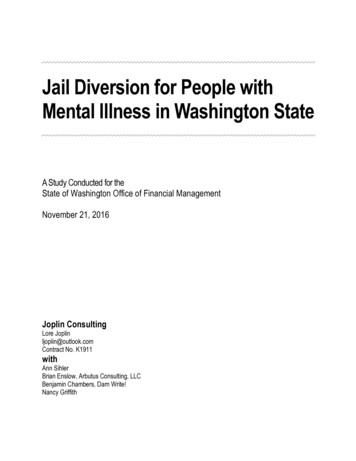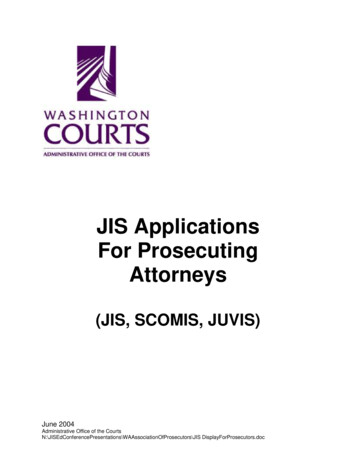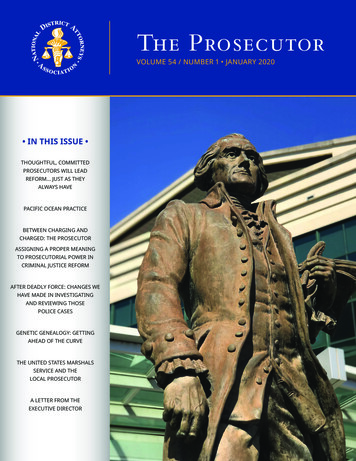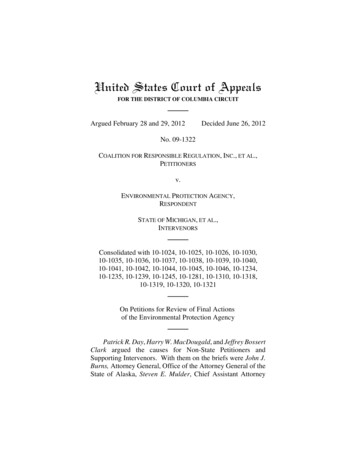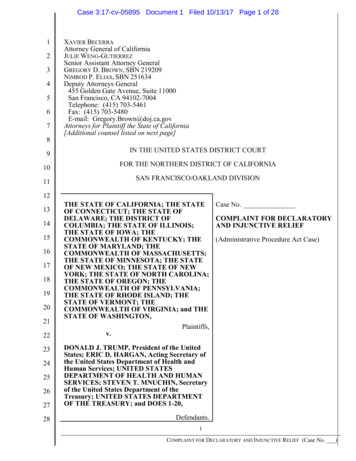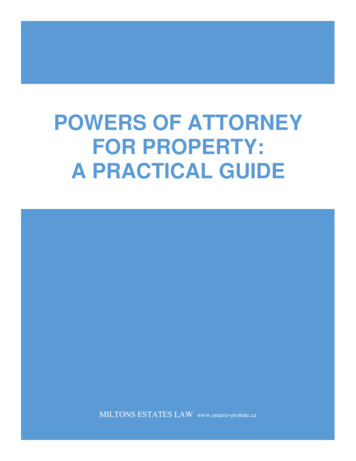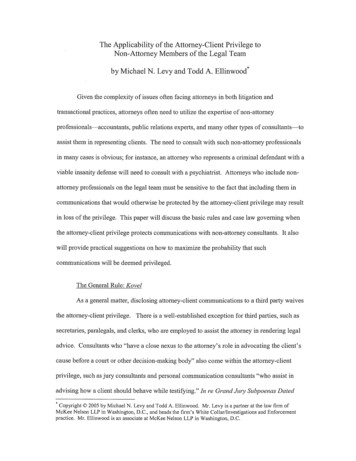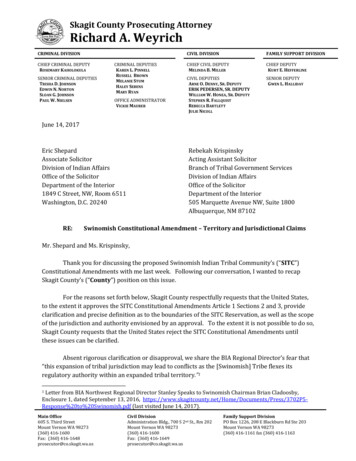
Transcription
Skagit County Prosecuting AttorneyRichard A. WeyrichCRIMINAL DIVISIONCHIEF CRIMINAL DEPUTYROSEMARY KAHOLOKULASENIOR CRIMINAL DEPUTIESTRISHA D. JOHNSONEDWIN N. NORTONSLOAN G. JOHNSONPAUL W. NIELSENCRIMINAL DEPUTIESKAREN L. PINNELLRUSSELL BROWNMELANIE STUMHALEY SEBENSMARY RYANOFFICE ADMINISTRATORVICKIE MAURERCIVIL DIVISIONFAMILY SUPPORT DIVISIONCHIEF CIVIL DEPUTYMELINDA B. MILLERCHIEF DEPUTYKURT E. HEFFERLINECIVIL DEPUTIESARNE O. DENNY, SR. DEPUTYERIK PEDERSEN, SR. DEPUTYWILLIAM W. HONEA, SR. DEPUTYSTEPHEN R. FALLQUISTREBECCA BARTLETTJULIE NICOLLSENIOR DEPUTYGWEN L. HALLIDAYJune 14, 2017Eric ShepardAssociate SolicitorDivision of Indian AffairsOffice of the SolicitorDepartment of the Interior1849 C Street, NW, Room 6511Washington, D.C. 20240RE:Rebekah KrispinskyActing Assistant SolicitorBranch of Tribal Government ServicesDivision of Indian AffairsOffice of the SolicitorDepartment of the Interior505 Marquette Avenue NW, Suite 1800Albuquerque, NM 87102Swinomish Constitutional Amendment – Territory and Jurisdictional ClaimsMr. Shepard and Ms. Krispinsky,Thank you for discussing the proposed Swinomish Indian Tribal Community’s (“SITC”)Constitutional Amendments with me last week. Following our conversation, I wanted to recapSkagit County’s (“County”) position on this issue.For the reasons set forth below, Skagit County respectfully requests that the United States,to the extent it approves the SITC Constitutional Amendments Article 1 Sections 2 and 3, provideclarification and precise definition as to the boundaries of the SITC Reservation, as well as the scopeof the jurisdiction and authority envisioned by an approval. To the extent it is not possible to do so,Skagit County requests that the United States reject the SITC Constitutional Amendments untilthese issues can be clarified.Absent rigorous clarification or disapproval, we share the BIA Regional Director’s fear that“this expansion of tribal jurisdiction may lead to conflicts as the [Swinomish] Tribe flexes itsregulatory authority within an expanded tribal territory.”1Letter from BIA Northwest Regional Director Stanley Speaks to Swinomish Chairman Brian Cladoosby,Enclosure 1, dated September 13, 2016, 3702P5Response%20to%20Swinomish.pdf (last visited June 14, 2017).1Main Office605 S. Third StreetMount Vernon WA 98273(360) 416-1600Fax: (360) 416-1648prosecutor@co.skagit.wa.usCivil DivisionAdministration Bldg., 700 S 2nd St., Rm 202Mount Vernon WA 98273(360) 416-1600Fax: (360) 416-1649prosecutor@co.skagit.wa.usFamily Support DivisionPO Box 1226, 208 E Blackburn Rd Ste 203Mount Vernon WA 98273(360) 416-1161 fax (360) 416-1163
Mr. Eric Shepherd and Ms. Rebekah KrispinskyJune 14, 2017Page 21.SITC Reservation Boundary. Skagit County shares the concerns regarding theMarch’s Point area discussed in Tesoro’s letter dated May 4, 2017 to Interior Secretary Zinke.2SITC has identified the March’s Point region as an acquisition target, an area of land valued at over 10 billion due to extensive existing industrial development. Contrary to SITC’s claims, it has beenestablished as a matter of law that the SITC reservation is bounded in the north by the 1873Executive Order. Nevertheless, SITC leadership’s repetitive, highly public assertions about thestatus of March’s Point are wrongfully devaluing property in the area,3 and we request that anyapproval of the SITC Constitutional Amendments make the legal northern boundary of the SITCreservation explicitly clear.2.SITC Off-Reservation Jurisdiction. As we discussed last week, Skagit County isextremely concerned about the implications of SITC’s off-reservation jurisdictional and territorialassertions. Specifically, SITC asks the United States to approve the following new constitutionallanguage:To the fullest extent possible consistent with applicable federal law andthe sovereign powers of the Tribe, the Swinomish Indian TribalCommunity shall have jurisdiction over all persons, subjects, propertyand activities occurring within (a) its territory as defined by this Article;and (b) the Tribe’s usual and accustomed fishing grounds and stationsand all open and unclaimed lands, as guaranteed by treaty for fishing,hunting and gathering, and on such other lands and water as is necessaryfor access to such fishing, hunting and gathering areas.Further, jurisdiction shall extend to all persons, subjects, property andactivities that may hereafter be included within the jurisdiction of theTribe.Proposed SITC Constitutional Amendment Article 1, Section 3.In addition, SITC proposes to amend its own constitutional definition of SITC “territory” toinclude “all lands, water, property, airspace, surface rights, subsurface rights and other naturalresources in which the Tribe now or in the future has any interest .” Proposed SITC ConstitutionalAmendment Article 1, Section ss/Zinke%20Letter%2005%2003%202017.pdf (lastvisited June 14, 2017).3 See, Letter from Board of Skagit County Commissioners to SITC Chairman Cladoosby dated April 5, 2017,copy available at st visited June 14, 2017).4 Black’s Law Dictionary defines “jurisdiction” as “[a] government’s general power to exercise authority overall persons and things within its territory,” and an “interest” as “[a] legal share in something; all or part of alegal equitable claim to or right in property.” Black’s Law Dictionary, 7th Edition, 816, 855.2
Mr. Eric Shepherd and Ms. Rebekah KrispinskyJune 14, 2017Page 3Skagit County first had the opportunity to review SITC’s proposed constitutionalamendments in October 2016, approximately 15 months after SITC initiated the amendmentprocess with the Department of the Interior.Shortly thereafter, we obtained a September 13, 2016 letter from BIA Regional DirectorStanley Speaks to SITC Chairman Cladoosby, which, in an enclosure prepared by the RegionalSolicitor’s Office, stated as follows:The proposal to modify Article I [of the SITC Constitution] presentssignificant changes to this section with expansive language to thejurisdiction and territory of the Tribe. The changes do presentcontradictions to applicable law. Additionally, potential conflicts mayarise if this amendment is enacted. The proposed amendment firstdefines the Tribe's territory and then secondly defines the Tribe'sjurisdiction.In the section defining territory, the proposed changes delete all thereference to the Executive Order of September 9, 1873 (Executive Order),in pursuance of Article III of the Treaty of Point Elliott, January 22, 1855(12 Stat. 928). The Executive Order (Attachment 3) defines the northernboundary of the Swinomish Indian Reservation. Removal of this languageis in contradiction to the Executive Order.Next, the section on jurisdiction includes "all persons, subjects,property and activities occurring within its territory as defined bythis Article." A potential expansion in territory as defined in the firstsection allows for a potential expansion of jurisdiction andregulatory authority as defined in the second section. If theproposed amendment is enacted, this expansion of tribaljurisdiction may lead to conflicts as the Tribe flexes its regulatoryauthority within an expanded tribal territory.5Letter to SITC from BIA Regional Director Stanley Speaks dated September 13, 2016, Enclosure 1 at 2-3(copy attached as Exhibit 1)(bolding added). A copy is available online s/3702P5-Response%20to%20Swinomish.pdf (lastvisited June 14, 2017).5
Mr. Eric Shepherd and Ms. Rebekah KrispinskyJune 14, 2017Page 4Since then, Skagit County has repeatedly attempted to engage SITC in dialogue, explicitlyseeking an explanation of the scope of the territory and jurisdiction SITC asserts under the Treaty. 6SITC has flatly refused to engage at any meaningful level, substantially exacerbating ourcommunity’s concerns.First and foremost, it is important to understand the context in which this arises. SITC isthe second largest of four federally-recognized tribes in Skagit County, with 540 Native Americansserved by the SITC reservation according to the 2010 census, while Skagit County representsapproximately 116,000 citizens. SITC tribal government employs approximately 200 individuals,an inordinate number of whom are litigation attorneys. Unlike most area tribes, SITC pays no percapita distributions to its members, instead directing its resources into activities such as the onepresently under discussion.Under its current leadership (Chairman Brian Cladoosby), SITC has, since the mid-90s,pursued a broad-ranging and programmatic effort to assert direct control over the Skagit Riverecosystem at the expense of its democratically-elected governments, asserting rights over taxation,land use, water rights and a broad range of issues on a constant and ongoing basis, with contentiouslitigation the norm, costing our county many millions of dollars in legal costs and deeply damagingrelations between tribal and non-tribal communities.By contrast, Skagit County has a warm and cooperative relationship with the other threefederally-recognized tribes in Skagit County. We recently negotiated mutual services agreementsregarding gaming and cannabis with the Samish Indian Nation, Skagit County’s largest tribe.7 Wejointly completed the largest habitat restoration project in our ecosystem, the Hansen CreekRestoration Project, located on Skagit County-owned land, in partnership with the Upper SkagitIndian Tribe.8Furthermore, Skagit County supports post-carbon initiatives that help create sustainabilityand resilience in our community, such as experiments in agricultural food production that alsoprotect salmon habitat functions and values.It is Skagit County’s strong preference to work on positive, creative, forward-lookinginitiatives such as this with our four local tribes, rather than remaining mired in the kind ofrevenge-based conflict ideology that appears to motivate SITC’s leadership.See, e.g., Letter to SITC Tribal Attorney Stephen LeCuyer dated April 24, 2017, available s/Letter%20to%20LeCuyer%2004242017.pdf7 “County and Samish Indian Nation Sign Compensation Agreement,” December 15, 2015,http://www.goskagit.com/all onagreement/article 736035db-d242-57aa-bf80-bf48e3807809.html (last visited June 14, 2017).8 “Upper Skagit Tribe Uses Groundbreaking Methods In Hansen Creek Project,” Northwest Treaty Tribes,October 15, 2009, -groundbreaking-methods-in-hansencreek-project/ (last visited June 14, 2017).6
Mr. Eric Shepherd and Ms. Rebekah KrispinskyJune 14, 2017Page 5We appreciate Chairman Cladoosby’s position as the current Chairman of the NationalCongress of American Indians through the end of 2017, and we understand his national role.However, Skagit County’s focus in on Skagit County, and we believe that sound public policydictates that the United States, in recognizing tribal sovereignty, also attempt to incentivize areasonable level of cooperation and peaceful coexistence. Recent years, in our view, have seendecidedly the opposite.The fact is that we cannot say exactly the nature, form and scope of the likely “conflicts asthe [Swinomish] Tribe flexes its regulatory authority within an expanded tribal territory,” but, likeRegional Director Speaks, we are certain they will occur. Following are a few examples.-SITC is claiming territorial jurisdiction over any land in which it claims an “interest.”SITC Constitutional Amendment Article I Section 2. We are concerned this is an effort toend-run the already-inadequate limitations on fee-to-trust acquisitions pursuant to the1934 Indian Reorganization Act.-If the Article I SITC Constitutional Amendments are approved by the United States aswritten, we believe it is a certainty that SITC will assert, in a broad range of proceedingsand fora, that the United States has endorsed SITC jurisdiction over anything thatimpacts treaty-protected fisheries or land in which SITC has any “interest.” Obviously,the ambiguity itself is concerning.-On the SITC website, SITC itself explains that the expanded jurisdiction and territorialclaims are necessary to achieve expanded “returned jurisdiction” and “newly delegatedjurisdiction,” specifically referencing the assertion of off-reservation jurisdiction underTreatment as States (TAS) authority pursuant to the Clean Water Act and Clean Air Act.9Skagit County believes that citizens of our county who own land off-reservation shouldbe able to buy and sell land with the certainty that they are governed and regulated bystate and county law, and not by the laws of the Swinomish Indian Tribal Community.Approval of the Article I SITC Constitutional Amendments, absent clear definition andclarification, will call that assumption into significant doubt.-It is critically important to recognize, given the outsized political, financial and legalpower that SITC wields over the local economy, press, local government and stategovernment, that the mere assertion of legal rights by SITC takes on a life of its owneven without a judicial decision. A good example is provided by the situation at March’sPoint, where property owners are suffering devaluation of their property, which SITChas previously identified as an acquisition target, simply because of SITC’s publicstatements about the status of their land. The Board of Skagit County Commissionershas explicitly asked SITC to litigate this issue in federal court, but SITC refuses,presumably because it perceives more advantage in holding this threat over ourSITC webpage, territory-and-jurisdiction/ (lastvisited June 13, 2017).9
Mr. Eric Shepherd and Ms. Rebekah KrispinskyJune 14, 2017Page 6community rather than having it decided. We believe that approval of the Article I SITCConstitutional Amendments will substantially increase situations of this naturethroughout our community.-An intersectional cause for concern is that the SITC Constitutional Amendments willremove Interior’s role in approving new SITC laws. See, SITC ConstitutionalAmendment Article II Section 2 (removing Secretarial review of tribal ordinances). Webelieve that if the Article I SITC Constitutional Amendments are approved withoutclarification, SITC intends to begin passing tribal ordinances that assert various forms ofoff-reservation jurisdiction that, SITC will contend, are consistent with federal law.This is the crux of the concern expressed by Regional Director Speaks’ letter.If the United States approves the Article I Constitutional Amendments without providingclarity as to their scope, it will necessarily fall to our small rural community to attempt to resistSITC overreach by asserting inconsistency with federal law, effectively condemning our small ruralcommunity to many more years of conflict and litigation with SITC.As we discussed last week, we believe that the mere reference in the SITC ConstitutionalAmendments to federal law consistency (“[t]o the fullest extent possible consistent with applicablefederal law and the sovereign powers of the Tribe”) will fail to constrain SITC’s ongoing pattern ofbehavior. Instead, it will incentivize a new round of SITC aggression against Skagit County and ourcommunity under the guise of expanded jurisdiction under federal law.In an April 24, 2017 letter to the Skagit County Board of Commissioners, BIA RegionalDirector Speaks opined that SITC might be attempting to claim jurisdiction over regulation of theirown treaty fishermen and hunters, citing U.S. Washington, 384 F.Supp. 312, 332 (1974) andMescalero v. Mescalero Apache Tribe, 462 U.S. 324, 330 (1983).In addition to being a small portion of the situation, this has already been the law for thepast four decades, and part of the SITC Constitution for the past eight decades. As you are aware,U.S. v. Washington (Boldt Decision) specifically allows for this right, and also makes clear that itcannot be expanded as SITC is now attempting:The Plaintiff tribes having a federally-recognized tribal governmenthave jurisdiction (in conformity with their tribal constitutions or otherapplicable tribal rules or federal statutes) to enact and enforceregulations relating to the exercise outside reservation boundaries bytheir members of fishing rights secured to said tribes by treaty.However, the tribes cannot enlarge the right beyond that securedin the treaty.1010384 F. Supp. at 403.
Mr. Eric Shepherd and Ms. Rebekah KrispinskyJune 14, 2017Page 7And the previous version of the SITC Constitution, in place for the past eighty years, alreadyprovided that SITC jurisdiction “shall extend to such other lands as may be hereafter added theretounder any law of the United States.” Prior SITC Constitution Article 1 Section 2.Thus, off-reservation regulation of tribal hunting and fishing is a right that SITCplainly already possessed, both judicially and under its own constitution. Accordingly, anassertion of off-reservation jurisdiction over its own members’ treaty hunting and fishing activitiescannot and does not logically explain why SITC is now going through so much trouble to claimjurisdiction, off-reservation, over “all land, water, and airspace [etc] in which the Tribe now or inthe future has an interest,” nor all “usual and accustomed areas” and “open and unclaimed lands”, aswell as lands “used to access” those areas.It seems patently clear from our perspective that SITC is spinning up a broad, new,expanded jurisdictional assertion that has not previously existed, which is exactly why RegionalDirector Speaks correctly took issue with the proposed new SITC constitutional language.While the proposed language regarding March’s Point and the 1873 Executive Orderwas modified prior to the SITC election, the jurisdictional language that Regional DirectorSpeaks found so troubling has not been modified. Thus, we continue to share RegionalDirector Speaks’ concerns about the SITC Constitutional Amendments.In light of the foregoing, any reasonable county government would be highly concerned. Onits face, SITC is asking Interior to recognize SITC jurisdiction over most of Skagit County, offreservation. As discussed below, this is inconsistent with both federal law and sound public policy.a. SITC’s Proposed Constitutional Amendments Violate The 1855 Treaty of PointElliott And Are Therefore Facially Inconsistent With Federal Law.SITC’s jurisdictional claim under the Treaty cannot be saved by a federal law consistencyproviso, because, as discussed below, SITC’s jurisdictional claim is inherently and explicitlyinconsistent with the 1855 Treaty of Point Elliott.SITC’s assertion of jurisdiction over “usual and accustomed fishing grounds and stations”and “open and unclaimed lands” arises from the 1855 Treaty of Point Elliott (“Treaty”), whichguaranteed the right to fish in common with the citizens of the territory. Applying the wellestablished canon of construction that treaties are to be interpreted as they would have been by thetribes signing them at the time,11 it has been judicially established that treaty tribes have the rightto half the available salmon harvest,12 the right to co-manage the fishery,13 and the right to enjoinWashington v. Washington State Commercial Passenger Fishing Vessel Assn., 443 U.S. 658, 675–676, (1979).U.S. v. Washington, 384 F. Supp. at 343-44.13 Id.1112
Mr. Eric Shepherd and Ms. Rebekah KrispinskyJune 14, 2017Page 8actions by the State that threaten treaty fisheries.14 In addition, the Treaty affords signatorytribes the right to “hunting and gathering roots and berries” on any “open and unclaimed lands.”Treaty Article 5.By their plain language, SITC’s constitutional amendments purport to extend these rights toassert jurisdiction over any off-reservation land with any arguable nexus to SITC’s claimed treatyrights or territory.When the Treaty was signed, tribes reserved fishing rights, reservations monetarypayments, and other rights, in consideration for which they released their sovereign jurisdictionover the remainder of the land base. See, Treaty Article I (“The said tribes and bands of Indianshereby cede, relinquish, and convey to the United States all their right, title, and interest in and tothe lands and country occupied by them ”) This should not be a particularly controversialcharacterization of the Treaty.That was the Treaty’s central point, and the benefit of the bargain. As SITC ChairmanCladoosby is fond of saying about the Treaty, “a deal is a deal.”15Should the United States approve the proposed SITC Constitutional Amendments as theyare written, we believe that SITC will assert that both the United States and SITC, as the parties tothe Treaty, have approved expanded jurisdiction under the Treaty. Again, as with many situationsprevious to this one, the mere assertion of this claim will have a tremendous impact on localgovernment and property owners, and our small rural community will be left on its own to defendagainst this dangerous and deeply undemocratic idea.For this reason, it critical that the United States carefully define the off-reservationjurisdiction and territory that the United States is endorsing by approval of the SITC ConstitutionalAmendments.U.S. v. Washington (Culvert Case), 853 F.3d 946 (9th Cir. 2017). Unlike the State of Washington, SkagitCounty does not disagree with the idea that tribes should have the right to enjoin specific state actions thatare substantially damaging treaty resources, based on a specific situation, supported by actual, scientificallysupportable evidence. But that is a far different question than endorsing tribal direct jurisdiction over offreservation land, people and resources.15 See, “Swinomish Angles for More Jurisdiction,” La Conner Weekly News, December 7, nID 2&subsectionID 160&articleID 1121 (last visitedJune 14, 2017).14
Mr. Eric Shepherd and Ms. Rebekah KrispinskyJune 14, 2017Page 9b. SITC’s Proposed Constitutional Amendments Violate The U.S. Constitution’sGuarantee Clause, And Are Therefore Facially Inconsistent With Federal Law.Skagit County Supports Consultation With Tribes, But Co-Management Of SkagitCounty With The Four Small Tribes Located Here Is Unworkable And InconsistentWith Representative Democracy.As you are likely aware, the philosophical underpinning behind SITC’s Article IConstitutional Amendment arises from the United Nations Declaration on the Rights of IndigenousPeoples (“UNDRIP”), and Article 32(2) in particular:Article 32(2) States shall consult and cooperate in good faith with theindigenous peoples concerned through their own representativeinstitutions in order to obtain their free and informed consent prior tothe approval of any project affecting their lands or territories and otherresources, particularly in connection with the development, utilizationor exploitation of mineral, water or other resources.Skagit County concurs with the UNDRIP’s “free and informed consent” on the 7,000 acreSITC Reservation – because we believe that local governments, tribal or otherwise, are entitled todemocratic governance and self-determination, SITC just as much as Skagit County.For example, Skagit County has not opposed SITC’s ongoing litigation with BurlingtonNorthern Santa Fe (“BNSF”) Railroad over unconsented shipments of Bakken crude across the SITCreservation.16Which is to say, Skagit County takes a very progressive view of tribal sovereignty on theSITC Reservation, but also believes that we need clear jurisdictional boundaries in order to avoidthe kind of pernicious conflict that has consumed our community for the past two decades, and,frankly, served few besides the large number of non-Indian litigators employed on SITC’s behalf.This is not about opposing tribal sovereignty as a concept, but rather, as the saying goes, theidea that clearly defined fences make for good neighbors.UNDRIP’s “free and informed consent” language has literal applicability in the context ofactually oppressed indigenous minorities such as the Karen in Myanmar, who are being subjectedto forced labor, forced resettlement and denial of citizenship and land rights on an ongoing basis.17Washington Tribe Wins Limit To BNSF Oil Shipping, Law360, June 9, gton-tribe-wins-limit-to-bnsf-oil-shipping (last visitedJune 12, 2017).17 Myanmar and the Karen Conflict, January 18, 2016 never-heard-of/ (last visited June 13, 2017).16
Mr. Eric Shepherd and Ms. Rebekah KrispinskyJune 14, 2017Page 10But it has considerably less literal applicability in the context of an American Indian Tribesuch as SITC, which represents less than 0.4% of our county’s population, and is fully assimilatedand ascendant in the dominant economic and governance model. Among other things, SITC holds aregional gambling monopoly and many other preferential rights including formal recognition as asovereign government, that, unlike any other government, can and does legally direct a significantamount of money to non-tribal political campaigns. SITC and its members are not disenfranchised.Rather, they are already super-enfranchised. Additional off-reservation jurisdiction is neithernecessary nor appropriate here.When announcing the United States was dropping its opposition to UNDRIP, the ObamaAdministration recognized that UNDRIP does not mean that each of the four tribes in Skagit Countyshould possess veto power over every governmental decision within any area over which a tribeclaims traditional, pre-colonization usage:[T]he United States understands [the importance of a] call for a processof meaningful consultation with tribal leaders, but not necessarily theagreement of those tribal leaders, before the actions addressed in theconsultations are taken.18Skagit County recognizes that these issues have taken center stage in the internationallypublicized opposition to the Dakota Access Pipeline (“DAPL”) adjacent to the Standing Rock SiouxReservation in North Dakota, planned to carry crude oil from the Bakken fields. While StandingRock leadership was consulted during the process, they declined to agree to the ultimate DAPL planapproved by the United States, leading to large scale protests.Skagit County is a highly environmentally progressive jurisdiction, which is perhaps whySITC has ignored our repeated invitations to discuss the substantive goals and concerns motivatingSITC’s expansive jurisdictional claims.19For example, Skagit County took the lead in successfully litigating the requirement that ShellOil prepare an Environmental Impact Statement (EIS) before constructing a Bakken crude-by-railWhite House Announcement of U.S. Support for the United Nations Declaration on the Rights of IndigenousPeoples, December 18, 2010, aration%201210.pdf (last visited June 12, 2017).19 See, Letter from Skagit County to SITC Tribal Attorney dated April 24, ress/Letter%20to%20LeCuyer%2004242017.pdf (lastvisited June 14, 2017).18
Mr. Eric Shepherd and Ms. Rebekah KrispinskyJune 14, 2017Page 11terminal in Skagit County,20 a project that has since been cancelled, largely rendering moot SITC’songoing litigation against BNSF over Bakken crude shipments.21As another example, Skagit County opposed the diversion of 5,000,000 gallons per day fromthe Skagit River for what would have been the world’s largest industrial water bottling operation.SITC tacitly supported this environmentally-devastating plan, which was ultimately withdrawn dueto local opposition from many others besides SITC.22Which is to say, SITC’s jurisdictional expansion cannot be justified by the idea of anunresponsive non-tribal government on environmental issues. Whatever this is about, it is notabout opposition to fossil fuel development or legitimate environmental concerns. It is, at its core,about SITC’s effort to dismantle representative democracy, an assertion of political control over anunrepresented majority for its own sake.It is worth noting that Skagit County, in one of many unsuccessful prior efforts to appeaseSITC leadership’s expansive ambitions, has already attempted to manage our ecosystem by firstobtaining SITC’s “free and informed consent,” going far beyond the consultation that even theObama Administration envisioned.For example, in 1996, SITC persuaded Skagit County to enter a water rights planningagreement which required consensus on all decisions pertaining to water allocation from the SkagitRiver, the third largest river (by discharge volume) on the U.S. West Coast.23SITC promptly “weaponized” the consensus requirement, opposing any decision pertainingto agricultural irrigation water. As a result, today, there is no water available for agriculture in theSkagit Valley, causing a great deal of hardship with no demonstrated benefit for treaty fisheries, inthe process upending Skagit County’s 50-year old democratically-established Comprehensive Plan“Judge Grants County’s Motion to Dismiss Shell Lawsuit; EIS To Continue As Planned,” Skagit Valley Herald,May 21, 2015, http://www.goskagit.com/all ll-lawsuiteis/article 96139fc3-17a5-5af7-9f42-ed9c322cf222.html (last visited June 12, 2017).21 “Shell Calls Off Rail Unloading Facility Project,” Skagit Valley Herald, October 6, f-rail-unloading-facility-project/article 8abcda56-e13c-5d90ab76-979694366750.html (last visited June 12, 2017).22 Email Exchange Between De
Mr. Eric Shepherd and Ms. Rebekah Krispinsky June 14, 2017 Page 2 1. SITC Reservation Boundary. Skagit County shares the concerns regarding the March's Point area discussed in Tesoro's letter dated May , to Interior Secretary Zinke. 2 SITC has identified the March's Point region as an acquisition target, an area of land valued at over
